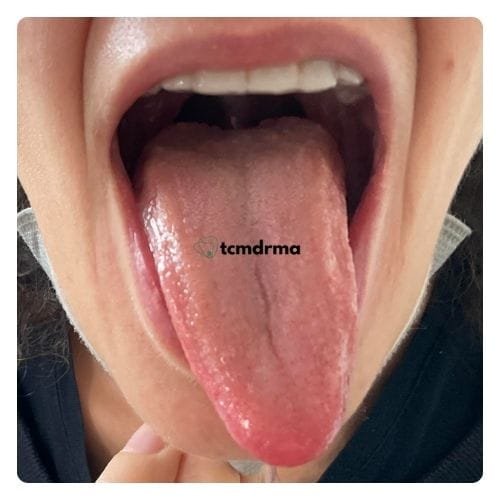
Brief Description
Sciatica refers to pain radiating along the path of the sciatic nerve, which runs from the lower back through the hips, buttocks, and down the legs. It’s often characterized by sharp, shooting pain, tingling, or numbness in the leg, which can worsen with movement. The condition is usually caused by a herniated disc, bone spur, or narrowing of the spine (spinal stenosis) that compresses the nerve.
In Traditional Chinese Medicine (TCM), sciatica is often seen as a result of Qi and blood stagnation in the meridians, particularly affecting the Bladder and Gallbladder meridians. Cold and dampness can also exacerbate the condition, leading to more severe pain and discomfort.
Common Misconceptions
TCM Diagnosis
Typical Tongue

Typical Pulse
In cases of excess patterns, the pulse is often wiry and rapid, indicating stagnation and heat. In deficiency patterns, the pulse tends to be thin and weak, reflecting a lack of Qi and blood or underlying organ deficiency. Pulse diagnosis plays a crucial role in guiding the treatment approach for sciatica in TCM.
TCM Pathogenesis
In TCM, sciatica is primarily due to Qi and blood stagnation along the affected meridians, such as the Bladder and Gallbladder meridians. External factors like cold, dampness, and wind can invade the body, aggravating the condition. In more chronic cases, underlying Kidney or Liver deficiencies may contribute to weakened meridian flow, making the sciatic nerve more vulnerable to injury and discomfort.
TCM Treatment
General Principle
In cases of excess patterns, acupuncture alone is often highly effective for treating sciatica. By stimulating the affected meridians, usually the Shaoyang meridian, the body is able to initiate self-repair, providing pain relief and healing.
For deficiency patterns, our clinical experience suggests combining acupuncture with herbal medicine. Acupuncture helps unblock the meridians, while herbal remedies replenish the body's deficiencies, significantly enhancing the overall effectiveness of the treatment.
Unique Therapies We Apply
Treatment Plan
Precaution
Summary
Sciatica is a painful condition that affects many people, but Traditional Chinese Medicine offers a natural and effective way to treat it. Through therapies like acupuncture and herbal medicine, TCM addresses both the symptoms and the underlying imbalances that cause sciatic pain. Timely treatment and proper care are essential to preventing the condition from becoming chronic, and patients are encouraged to stay active and avoid cold exposure during recovery. By following a comprehensive treatment plan, sciatica sufferers can find lasting relief and improved mobility.

The Traditional Chinese Medicine treatment approaches outlined above are derived from my clinical experience, and I acknowledge there may be areas not fully covered or that require further refinement over time.
This content is intended to provide a learning reference for professionals and enthusiasts in Traditional Chinese Medicine and to help patients gain a better understanding of their conditions and common misconceptions.
However, I must emphasize that this information does not constitute specific treatment guidance. All TCM treatments must be tailored to the individual through thorough diagnosis by a qualified practitioner. Non-professionals should not attempt self-treatment based on this information, as any treatment conducted without professional supervision may carry potential safety risks.
